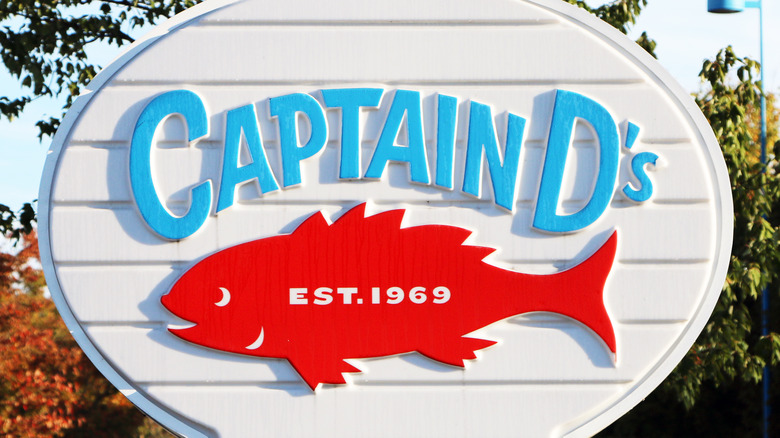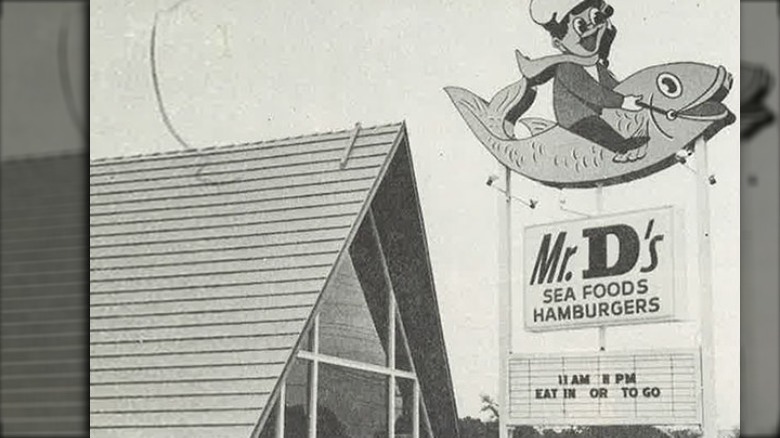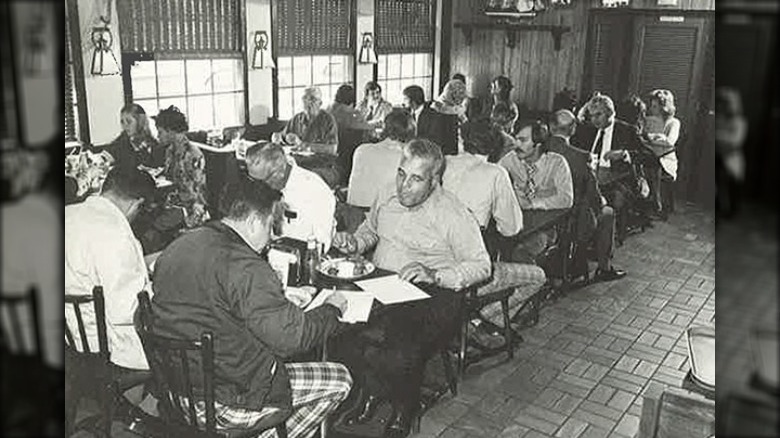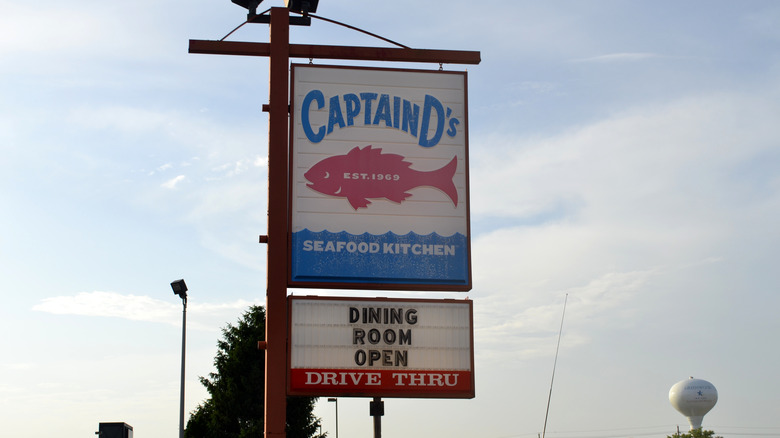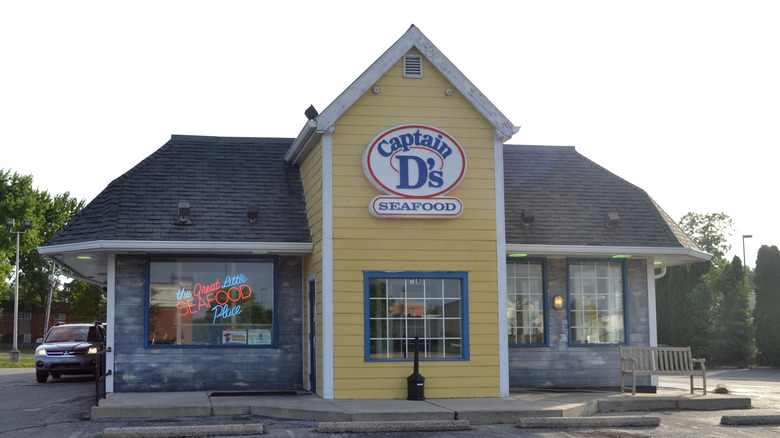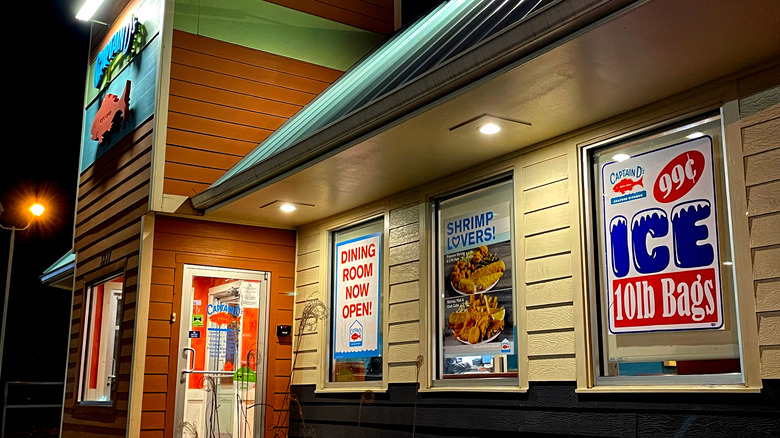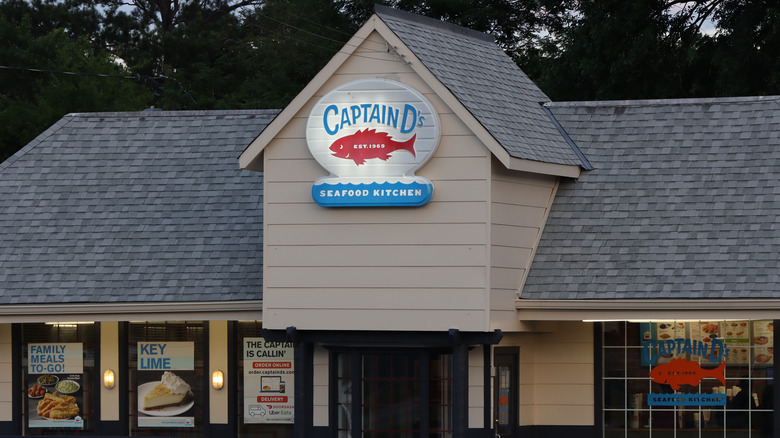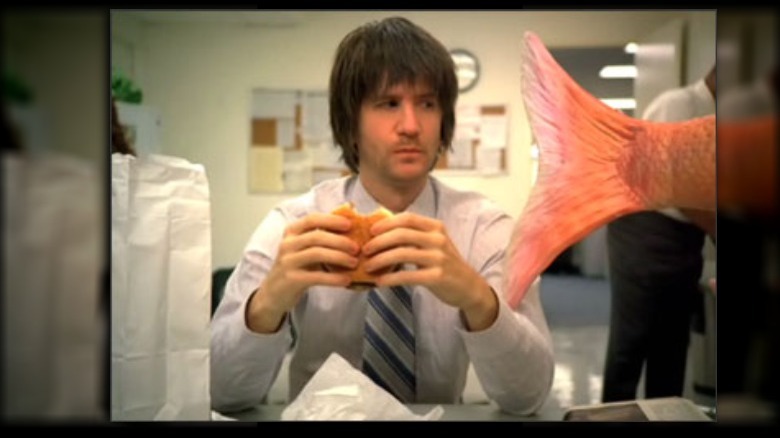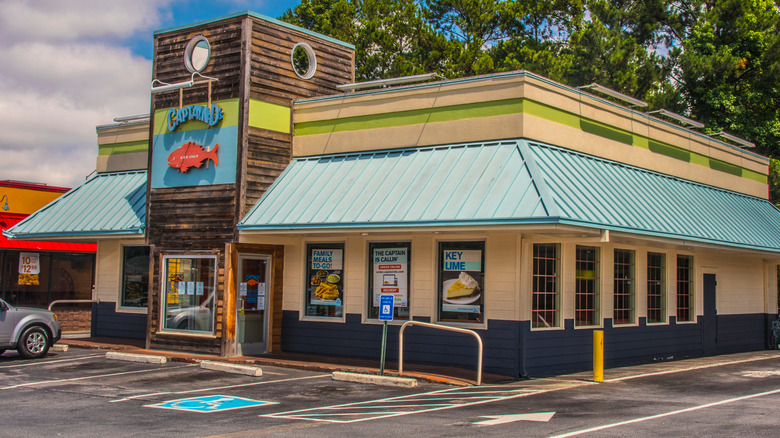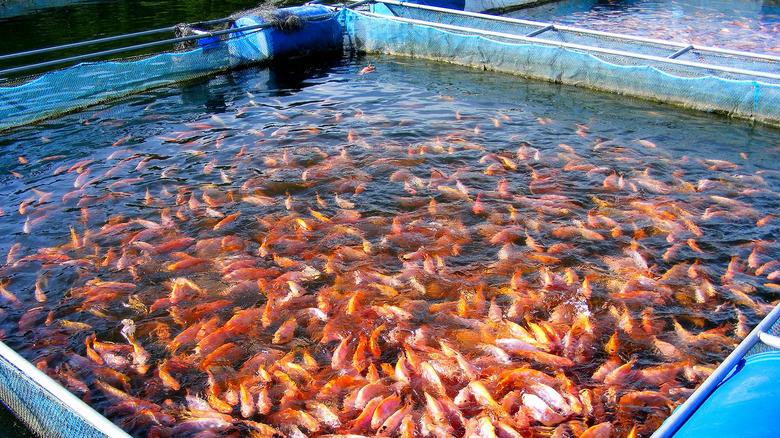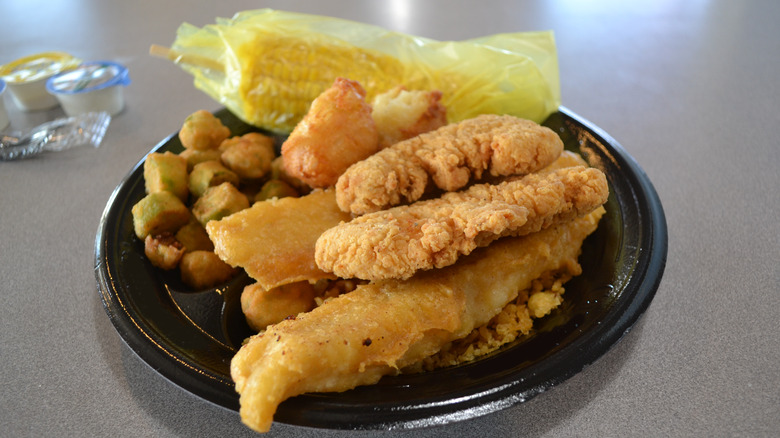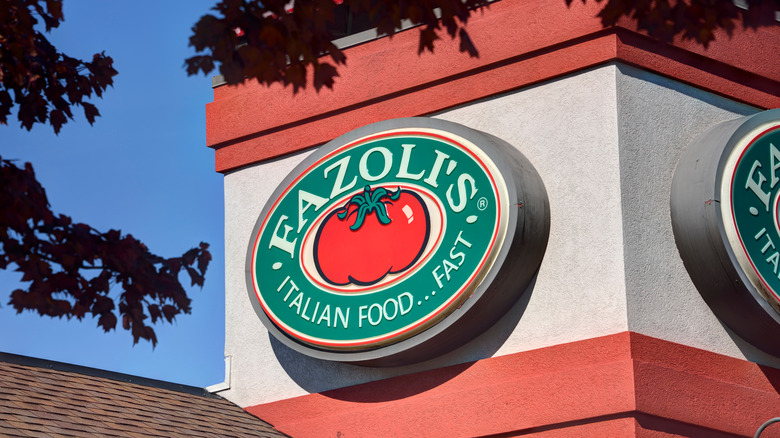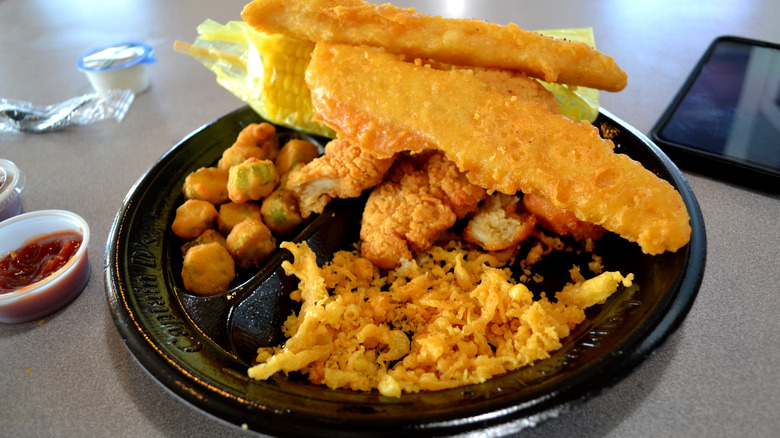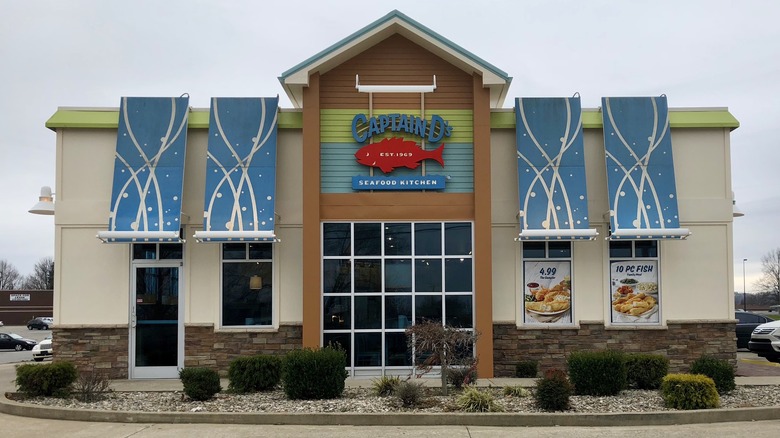The Untold Truth Of Captain D's
With more than 500 restaurants scattered across more than 20 states, chances are likely that you've come across a Captain D's at some point in your life. This seafood-focused fast food chain was founded in 1969, but it's still growing at a rapid rate across the United States.
In 2020, Captain D's announced that QSR Magazine had named their brand the top seafood franchise restaurant for the year, based on system-wide sales of an estimated $562 million and annual unit volume of $1.5 million, well ahead of other big seafood fast casual restaurants such as Long John Silver's. As the nation's top fast-casual seafood franchise, Captain D's also gained a spot on QSR Magazine's list of Top 15 Fast Food Contenders to Watch.
Even over the course of a pandemic that proved devastating to some restaurants, Captain D's managed to rake in that considerable money in U.S. systemwide sales (and that's not counting the international Captain D's locations at military bases across the globe). It appears that the company has no intention of slowing its growth, either, go so far as to roll out a brand-new restaurant concept in late 2020 that could keep Captain D's going well into the future. But perhaps we're getting ahead of ourselves. So, how did Captain D's get its start, and what's behind its success? Here's the untold truth of Captain D's.
Captain D's hasn't always been Captain D's
First of all, Captain D's didn't start out as Captain D's. The restaurant chain's original name was actually "Mr. D's". The "Captain" moniker wasn't added until 1974, a full five years after the restaurant got its start in 1969, according to Captain D's. But don't think that the Captain D's brand stemmed from some small, family-owned eatery that just happened upon some luck and great marketing. This restaurant has always held corporate roots, as a Funding Universe profile notes.
It was Danner Foods, Inc., based out of Nashville, that created the first Mr. D's restaurant, which opened on August 15, 1969, in Donelson, Tennessee (via Captain D's). Already, Danner Foods was known for running Big Boy restaurants across the southeastern United States. The publicly held company was well-positioned to launch a brand-new seafood restaurant when it did so in the late 1960s and so Mr. D's was born, more or less as an expansion to the Danner Foods portfolio.
This Captain D's predecessor had the funding and the management necessary to make it a success from the start, so it's no surprise that the restaurant concept lived to see its first rebranding in 1974, when the name changed to Captain D's.
The original Captain D's looked very different
While Mr. D's did indeed open as a seafood restaurant, it still was pretty unrecognizable from today's Captain D's restaurants. First of all, as the Captain's D's of today explains, the chain's full name was Mr. D's Seafood and Hamburgers and the specialty was still seafood on a budget. Yet, as the original name may have hinted already, the menu also included non-seafood items like those hamburgers — which you definitely won't find on a Captain D's menu today.
The theme of the restaurant was pretty different, too. While the signage boasted a happy chef riding astride an equally happy fish, the restaurants' exterior and interior didn't give you that seafood shack vibe that today's Captain D's franchises do. Instead, everything looked pretty similar to a family-style restaurant of the 1970s, with plenty of brown tile, wood-paneled walls, and dining tables that weren't too different from tables that you could find in your average family home dining room.
The look didn't stick around long, though, as Captain D's went fully nautical with its decor when it also changed its name in 1974.
Captain D's faced big challenges in the 1990s
In the 1990s, Captain D's introduced drive-thru windows and did a little more brand repositioning, but that wasn't enough to completely keep Captain D's from feeling the impact of falling seafood consumption. According to Funding Universe, seafood consumption fell to 14.8 pounds per capita in 1992, down from 15.9 pounds per capita in 1989 (for reference, the 1980s saw a 25% growth in seafood consumption overall). But why did the restaurant (and other seafood places, for that matter) see such a noticeable fall in the public's appetite for seafood in such a short time?
First, it wasn't always easy for Captain D's to source its seafood from its normal vendors during this time. That's because some fish species were in short supply and international vendors had begun to shoulder their way onto the marketplace. Shortages resulted in high costs for key restaurant favorite species like sole, scallops, and cod. This was clearly a major issue for a chain like Captain D's that touted its budget-friendly menu. However, on the opposite end of things, if Captain D's kept its prices too low, customers might worry about where the fish was sourced and the level of its quality. But, as a looming legal battle would prove, it wasn't just the price of cod that would make this decade tricky for the seafood franchise.
Captain D's was once involved in a discrimination lawsuit
As Captain D's faced falling seafood consumption, it also faced a pricey lawsuit in 1992. In November of that year, AP News reported that Shoney's Inc., Captain D's parent company at the time, would be forced to pay $105 million to settle a racial discrimination lawsuit. In the suit, nine Black employees at Shoney's and Captain D's restaurants said they experienced discrimination from their employers between 1988 and 1991. Discriminatory practices were reported in the hiring, termination, and promotion processes for the chain, and the charges included both harassment and retaliation against those who spoke out. In addition to the settlement payment, Shoney's Inc. was also forced to take a look at its hiring practices and increase the number of Black employees hired by the company.
As a result of the lawsuit, Shoney's, and likewise Captain D's, was far in debt and forced to sell off assets, according to Funding Universe. Said assets included all of its branded chains, with the exception of the Shoney's restaurants and Captain D's locations.
Captain D's decreased its restaurant size in the 2000s
In the 2000s, Captain D's came upon a new idea that would save money and increase profits: make the restaurants smaller overall. And when Captain D's decided to go smaller, they really went for it, cutting their standard restaurant size down by about two-thirds compared to the original size of each location. Whereas the earliest Captain D's restaurants could seat an estimated 128 diners, the new, smaller restaurants that launched in 2001 could only seat 42 diners. The square footage of each restaurant decreased from 3,250 square feet to 1,800 square feet, dramatically changing both the footprint and surely the experience of dining in a Captain D's franchise (via Funding Universe).
Though it may seem like a dramatic downturn, the change actually came with a lot of benefits, as Funding Universe explains. First of all, the smaller restaurants were easier and faster to build and the furnishing and equipment costs were much cheaper compared to their predecessors. The revamped kitchen design also allowed for ample service and throughput, but with fewer employees. The smaller restaurants could also fit into more locations, allowing the brand to pop up in spots like strip malls, for example. This benefit was crucial for Captain D's next move: expanding into previously unmarked territory, which would eventually take the brand international.
Captain D's only international locations are on army bases
When Captain D's adopted its smaller restaurant size, it opened up the door for new locations in previously off-limits spots, such as on far-flung army bases. In 2001, as Funding Universe details, Captain D's opened its very first army base restaurant at Travis Air Force Base in California. This would eventually further open the door for new locations, as Captain D's became an increasingly popular choice on army bases and the option to add locations at the 150 or so military exchange food courts became a possibility. The move also allowed for Captain D to open up its very first international location at the Okinawa Air Force Base in Japan.
Beyond Captain D's international military base locations, though, it seems as if the brand is keeping its expansion sights set firmly on home turf, with more than 20 target growth states throughout the United States, with efforts focused primarily in the Midwest and South. The brand lacks a presence in only 14 states as of 2021.
A Captain D's ad was called almost upsetting to watch
While the changeup in restaurant size seemed to be working in the franchise's favor, not everything that Captain D's attempted in the 2000s was a success. In 2008, Captain D's ran a television ad that featured a large fishtail that would appear whenever an actor was making a "poor" dining decision. The fishtail would proceed to violently smack the diner in what was intended to be a humorous manner. An office worker eating a burger gets smacked. A husband bringing a box of pizza home to his wife gets smacked. After everyone's been thoroughly smacked around, the disembodied fishtail provides a Captain D's dinner.
The ad was not well received, to say the least. One Nation's Restaurant News writer called the fishtail "an aggressive sea monster," saying that the violence portrayed in the commercials was "almost upsetting to watch."
The maker of the fishtail even admitted that, while he intended to make the tail as slap-friendly as possible, some of the actors that appeared in the commercials still left the set with "sore jaws and red faces" due to the intense slapping.
Captain D's revamped itself again in the 2010s
Ultimately, Captain D's wasn't doing well in the 2000s, despite the brand's rather smart idea to scale down its restaurants and its less popular ad campaign. According to QSR Magazine, from approximately 2003 to 2011, the brand saw zero same-store sales increases, a pretty rough sign for the restaurant. But, things would turn around for Captain D's as it overhauled its look and its menu over 2011 and 2012, resulting in its largest-ever same-store sales growths in 2012.
The new look took Captain D's from a sad blue seaside seafood shack with weathered docking (something you may want while vacationing in Maine, but perhaps not while you're grabbing fast food in the middle of Nebraska) to a colorful cafe with the only nautical nod being the bright red fish on the chain's signage and the occasional porthole-inspired detail. As for the menu, Captain D's revamped its long-standing fried fish product, launched new fish stick-like items, started offering grilled and broiled options. The chain even upped the ante with some higher-end menu options, like steak and salmon. All of the changes helped turn Captain D's future in a more positive direction.
Captain D's sources its fish from a many places
More and more, consumers are concerned about where restaurants source their food, particularly when it comes to a sometimes shady seafood industry. If you're trying to make your seafood consumption a little more sustainable, the sad truth is that you may want to avoid a few items on the Captain D's menu. While Captain D's sources some of its products in an admirably sustainable fashion, some of its products are a bit more suspicious.
According to an interview with Captain D's head chef published by AL.com, most of Captain D's fish is wild Alaskan cod. The fish are caught via tech-heavy fishing boats outfitted with video cameras that monitor the fish in the nets, in order to avoid overcrowding in the net. The fish is then frozen in an Alaskan factory and shipped to Captain D's.
In terms of sustainability, you'd probably prefer this wild-caught cod to some of the other seafood at the restaurant. Captain D's sources a significant portion of its seafood from fish farms, including catfish, tilapia, white fish, and salmon. The farmed tilapia is particularly concerning, as farmed tilapia is known to be both bad for your health and the environment. The New York Times reports that tilapia farms can pollute local ecosystems with large amounts of fish waste, some fish may be treated with hormones like testoserone, and the fish themselves lack much of the healthy omega-3 fatty acids that are present in other species.
Lent is Captain D's busiest season
That farmed fish isn't slowing some consumers down, though, especially around Lent. Those are the 40 days during the spring when many Catholics abstain from red and white meat on certain days throughout the period before Easter. And when you can't eat red or white meat, you're not left with a lot of options, especially when it comes to fast food. That's where fish comes in.
The same Captain D's head chef quoted in the AL.com article says that Lent is "a big time of year" for the chain, with the 40 days significantly and noticeably impacting sales. Regular customers come in for fish more frequently during Lent, and new customers come to Captain D's to find alternatives to some of the other fishy fast-food options. Those other alternatives include what the chef unflatteringly describes as "a square fish patty that's pressed and formed" — something he notes that Captain D's steers clear from, opting to offer customers a range of other fried and grilled fish meals.
Captain D's is now owned by Sentinel Capital Partners
The Captain D's name has changed hands several times over its existence. When the restaurant was struggling in the early 2000s, Shoney's Inc. went private and Dallas-based Lone Star Funds took over, as reported by the Nashville Business Journal. The takeover included 308 Shoney's restaurants and 560 Captain D's restaurants. At the time, Lone Star Funds promised to drop a hefty investment into strengthening both brands.
In 2017, though, private equity firm Sentinel Capital Partners, acquired the Captain D's brand, which then consisted of 530 restaurants, as 1851 Franchise reports. Sentinel Capital Partners is certainly no stranger to the restaurant business, as it also has its hands in other fast food and fast casual restaurants like Taco Bell, Church's Chicken, Fazoli's, Pizza Hut, and TGI Fridays, among others. When acquiring the name and concept, the goal was to expand Captain D's into new regions (a goal that the team has since fulfilled). Meanwhile, Captain D's CEO, Phil Greifeld, stated that "our brand has never been stronger."
There's a name for those crispy morsels that come with your fried fish
If you order Captain D's fried fish, you'll notice that your fish is accompanied by little crispy bits of fried batter that ended up in the frier alongside the fish. The end result is something often referred to as "cracklins" and, for some customers, these crispy bits of leftover batter are quite possibly the best part of a piece of Captain D's fried fish. But you don't need to order the fish to get the cracklins, as it turns out.
According to Cafe Mom, you can order a side of the cracklins alongside your Captain D's meal and you'll almost certainly get them for free. You can, of course, eat them on your own or add them to your salad for a crispy, crunchy, flavorful treat. And yes, as one Twitter user points out, when you ask for the cracklins, they give you a big container of what is essentially fried fat. But, as that Twitter user admits, it can also taste amazing.
Captain D's looks to the future with a new restaurant concept
Captain D's has continued to make waves in the fast-food industry even recently with the launch of a brand-new restaurant concept in 2020, called Captain D's Express. It's a move that feels pretty similar to Captain D's earlier decision to scale down its restaurant size in the early 2000s. In fact, the new Captain D's Express is even smaller than the current traditional Captain D's restaurants.
Designed for metropolitan settings and to fit on less than a half-acre of land, Captain D's Express locations feature no indoor dining rooms at all. Instead, they offer drive-thru windows and walk-up windows, meaning that these locations will offer takeout only. The result is a restaurant that's both more affordable to run and more affordable to start up, as Captain D's claims that the size reduces franchisee startup costs by nearly a third compared to the larger restaurants. The new design works well, too, given Captain D's increase in take-out and drive-thru service over the course of the COVID-19 pandemic. In fact, as ghost kitchens continue to pop up and many diners claim they will continue to keep ordering delivery and takeout, this may not be such a bad move after all.
Want to see a Captain D's Express for yourself? The first one opens in Atlanta in 2021, with plans for two more Atlanta locations in the near future.
